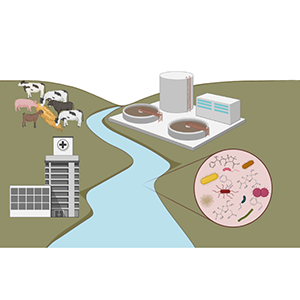Contact
Department of Aquatic Sciences and Assessment, Division of Environmental Organic Chemistry and Ecotoxicology
Department of Aquatic Sciences and Assessment, Division of Environmental Organic Chemistry and Ecotoxicology

This VR project aims to advance our knowledge on the transformation mechanisms and processes of antimicrobial chemicals, as well as the potential impact of their transformation products (TPs) on the emergence of antimicrobial resistance, in recipient aquatic environments.
Antimicrobial resistance is a growing health threat to human and the environment. Anthropogenic contamination with antimicrobial chemicals is the major factor for the emergence of resistant bacteria in the environment, promoting the proliferation and transmission of antibiotic resistant genes (ARGs).
Insufficient treatment efficiencies of wastewater treatment plants (WWTPs) result in effluent discharges with antimicrobial chemicals into aquatic environments, such as surface waters and groundwater. Most antimicrobial chemicals are considered ‘pseudo-persistent’ due to their continuous discharge and degradation to potentially more persistent TPs in the environment. Hence, the understanding of compound-specific transformation pathways, influenced by biotic and abiotic environmental factors, can be important in the risk assessment.
Since many TPs share similar molecular structures with their corresponding parent compounds, they might have similar biological activities and environmental behaviors, acting as a derivative class to antimicrobial chemicals. However, there remains a large knowledge gap regarding the contribution of TPs to the antimicrobial resistance in the aquatic environment.
Development of innovative bioanalytical strategies to identify new TPs in freshwater microcosms
This WP aims to identify and elucidate aquatic new TPs of selected antimicrobial chemicals using bioanalytical strategies. A suspect screening with in silico degradation prediction models and a non-target screening for potential TPs using case-control filters will be applied using high-resolution mass spectrometry (LC-Orbitrap-MS). Key TPs will be isolated via fractionation for further experiments and analyses.
Microcosm experiments to identify the impact of TPs on the aquatic resistome
The impact of TPs on the expression of ARGs and mobile genetic elements (MGEs) in freshwater microcosms (e.g., recipient surface water, groundwater) will be investigated. The influence of TPs alone and the co-presence with parent compounds will be investigated, as well as the impact of biotic and abiotic (e.g., UV-light, pH, etc.) factors.
Verification of TP, ARG and MGE microcosm profiles with freshwater ecosystems
A field study will be performed to investigate the spatial profiles of TPs, parent compounds, ARGs, MGEs and microbial communities in freshwaters across (inter)national locations. The relationship between the microcosm experiments and the field study will give valuable insights on potential indicators for future applications.
This project is in accordance with the National Environmental Quality Objectives by the Swedish Environmental Protection Agency, more specifically with the Objective 4 “Non-toxic environment” and Objective 9 “Good quality groundwater”. Furthermore, it is compliant with Goal 6 “Clean water and sanitation” by the UN sustainable Development Goals.
Paul Löffler (SLU, Sweden), Foon Yin Lai (PI, SLU, Sweden), Christine Baduel (IRD, France), Windi Muziasari (Resistomap, Finland), Christoph Ort (Eawag, Switzerland)
The project is funded by The Swedish Research Council (Vetenskapsrådet).